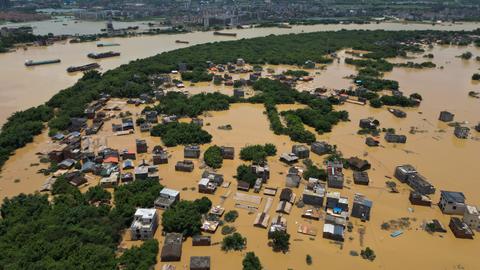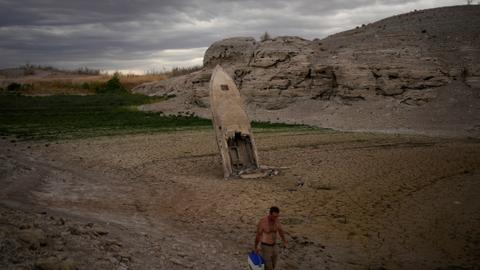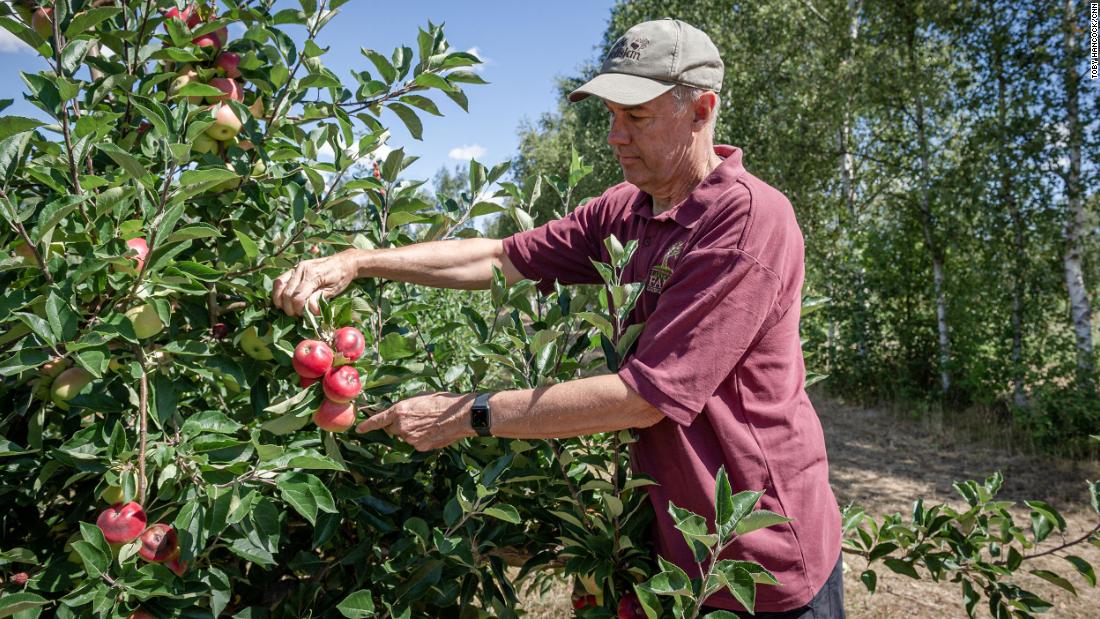Walking through their orchard on Lathcoats Farm, the apples on many trees have been visibly scorched, their skin browned in parts, the flesh underneath turned corky. A significant proportion of the farm's harvest this year has been unsellable.
A record-breaking heat wave in July literally baked the apples on their branches, but Philip Taylor, who runs the farm with his nephew, now has bigger things to worry about. The soil under the trees is cracking with dryness -- they've had such little rain this spring and summer. Even this past winter, when rainwater typically stores up in the soil to keep it moist for months, just wasn't wet enough.
England last month had its driest July since 1935, and the southern part of the country, including Lathcoats Farm, received just 17% of its average rainfall for the month, according to the UK Met office. No meaningful amount of rain is on the horizon either.
Water levels in reservoirs are dropping fast and rivers are drying up. Even the River Thames that flows through London has shrunk, its first 5 miles dried and disappeared. Thirteen rivers that the Environment Agency monitors are at their lowest levels ever recorded.
The climate crisis, driven by burning fossil fuels, is making
hot weather, drought and flooding more frequent and intense in the UK, and the hotter the planet gets, the worse these impacts will be.
But for farmers of thirsty crops like apples, there is no replacement for rain straight from the sky.
"Growing apples is not going to work if we have summers like this every year," Taylor told CNN at his farm, a 40-mile drive northeast of London. "Our access to water at the moment is purely from the mains. To give apple trees enough water to produce a decent crop would be way too expensive."
Luckily, Taylor has other means of income. His family has transformed the farm into an attractive place to visit, with a café and a farm shop that sells juice made from Lathcoats' apples, fresh produce, organic bread and cakes. People also come here to pick their own fruit, making for a fun day out, for young children in particular.
He and his nephew sell soft fruits as well, like berries and plums, which can be watered with irrigation. But even that water is becoming scarce, and they can't afford to put in some of the measures bigger farms do to shield from extreme weather.
"So as far as what we're doing about it, well, we're just sort of worrying," Taylor said. "It may be that we just go away from growing apples. Certainly, we will consider which varieties we might plant going forward. Some would be more resilient in these temperatures than some of the traditional English ones that we grow now."
3 billion liters of water lost in leaks each day
Hosepipe bans are forcing people to find less wasteful ways of replenishing their gardens and washing their cars. Filling up a paddling pool, as some English people do on hot days, is banned in many areas as well.
But it's not just consumption that's a problem, or even the lack of rain -- the United Kingdom's infrastructure is several hundred of years old and is particularly leaky. In England and Wales, 3.1 billion liters of water -- enough to fill 1,240 Olympic-sized pools -- is lost through leaks every single day.
"There's a real lack of respect for the water that we've got, this really, quite precious resource," Hannah Cloke, a climate scientists and hydrologist at the University of Reading, told CNN. "We drink it, we use it to grow our food, and yet we are still letting it leak all over the place. That's one of the biggest issues. The water companies are just letting it leak -- they've really dropped the ball there."
Water UK, which represents 12 major water companies across the country, said that a lot had already been done to plug the leaks.
"Companies have increasingly been putting innovation and technology at the heart of these efforts," the organization said in a statement to CNN. "Intelligent networks, smart sensors, satellite technology and drones are all part of the armory that's being deployed to detect and fix leaks faster than ever."
The companies represented by Water UK are also planning to invest £14billion ($17 billion) in reservoirs and schemes to move water around the country, "enough to supply 10 million people," so it can be saved for particularly dry times like this one.
Another issue is that only around half of the homes in England and Wales have water meters, which allow companies to charge customers based on their actual usage. The rest just pay what the companies estimate a home of their size might use.
The wider UK has the highest per capita water consumption across Europe, using up more than 140 liters a day. Metering has proven to reduce water consumption by more than 20%. Without them, there's little incentive to cut down on use.
Cloke said that water companies might not want to expand metering, which could eat into their profits, assuming people would be more careful with their consumption.
"Water companies will want to make money from selling water, so it's in their interest to keep selling, even when there are restrictions in place," Cloke said. "We haven't got this quite right, but water companies don't have the incentive to do the right thing, environmentally speaking, and that goes for pollution and flooding, as well as droughts and leakage. It has been very much a case of 'Let's just carry on, business as usual.'"
The UK's Centre for Ecology and Hydrology on Wednesday warned that drought conditions, which are now impacting much of the country, could last until at least October. The center only looks a few months ahead, and there are worries that the country could have a second, consecutive dry winter as well, even roll into next year.
That could be catastrophic, not just for households, but also for food security, already undermined by Russia's war in Ukraine and drought in other parts of Europe. It would also push food prices up even higher, fueling inflation that is already painful for millions of people in the country, as mortgage rates and rents go up, and energy prices soar.
As Taylor told CNN from his farm, it's been one thing after another.
"Everything's happened at once," he said. "You could start with Brexit and go on to Ukraine, and then Covid. And now climate change is really starting to hurt."
The Garden of England withers
On the other side of London, down south, the English county of Kent is known as the Garden of England for its green rolling hills, its fertile land and orchards that supply the nation with strawberries, apples and pears. It's also a place that attracts those with green thumbs, who move here and cultivate large gardens in their homes.
David and Margaret Miller have lived in their home in the Kentish town of Edenbridge for around 40 years. The couple showed CNN photographs of what their garden once looked like -- a lush green oasis of geraniums, azaleas, dahlias, cannas and echinacea plants. They also brought out several certificates to show their accolades from the local Edenbridge in Bloom gardening competition, which they have won multiple times.
Now their front lawn is dried out and brown from the lack of rain. Some of their dahlias haven't blossomed at all in the heat, and the pink echinacea flowers have completely withered, their petals drooping.
The couple have made the decision to try and just water the flowers and plants they care for the most. Even though they aren't subject to a hosepipe ban yet, they have switched to watering cans "to do the right thing," Margaret Miller said. That's made what was once a 30-minute job twice as long. In this heat, sometimes they need to water their select few plants twice a day just to keep them alive.
It's not an easy job for David, who is 84 and suffering from vertigo, or Margaret, 80, who has problems with her hip. And their garden is everything to them. A hobby and a sanctuary that got them through the worst of the pandemic.
"When you see them all withering in the heat, you feel sad," said Margaret Miller of her plants. "Because, over a period of time, you have nurtured them."
She agrees that people should conserve water as a precious resource, but she's frustrated that her garden has to suffer while the country loses so much in leaks every day.
"I feel quite cross about it, because they then come up with a reason like 'Oh, we've got a drainage system that dates back several hundred of years, and it's not the water companies' fault.' But I would have thought, in this day and age, they've got equipment that they can tell where these leaks are and fix them," she said. "I'm sure they're making plenty of money, so why don't they plow it back in? It does make me cross."









